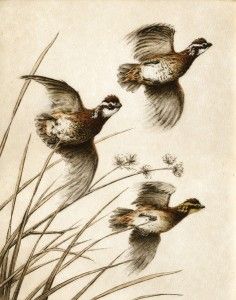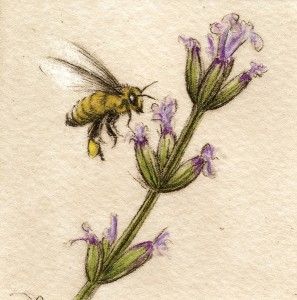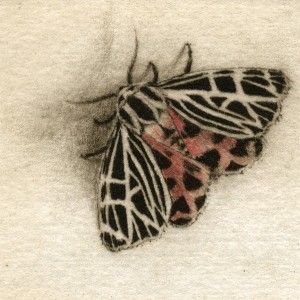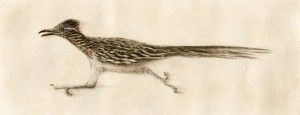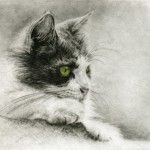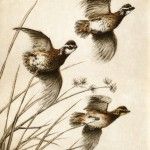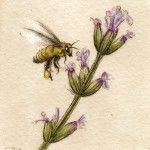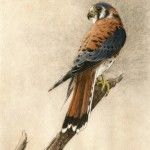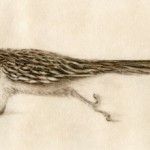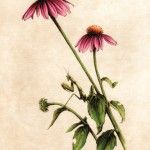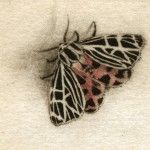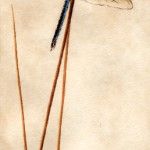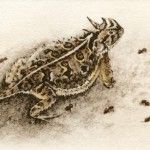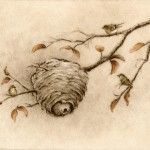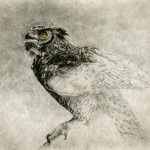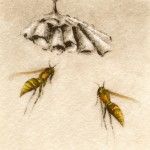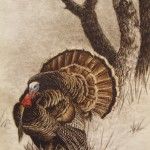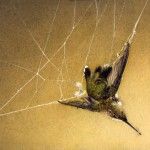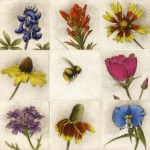Melanie Fain’s etchings reflect the simple pleasure of looking at nature
By Bonnie Gangelhoff
This story was featured in the August 2015 issue of Southwest Art magazine. Get the Southwest Art August 2015 print issue or digital download now–then subscribe to Southwest Art and never miss another story!
Melanie Fain knows all about the birds and the bees, artistically speaking. For more than 30 years she has photographed them, drawn them, and captured them in her award-winning etchings and watercolors. Two of Fain’s works are in the permanent collection of the highly regarded Leigh Yawkey Woodson Art Museum in Wausau, WI. And, as this story was going to press, Fain was preparing to show her work at the Plantation Wildlife Arts Festival in Thomasville, GA.
Although she creates the occasional watercolor, the majority of her artworks these days are etchings, which she often shades with vibrant pastels or watercolors. When it comes to style, the Texas-based artist is a big proponent of the “less is more” philosophy. Her etchings cast the bug, bird, or botanical in the limelight as the star of the show, and each creature or flower is usually surrounded by generous negative space, ensuring that viewers can fully appreciate the array of stunning patterns, colors, and shapes Mother Nature offers. Fain’s intent: To leave room for viewers’ imaginations to roam freely. “I want to reflect the simple pleasure of looking at nature,” she says. “That’s why I try to stay simple and don’t clutter my work with a lot of background. I want you to really see the bird, bug, or flower.”
While many artists are drawn to flowers and birds as subjects, what makes Fain somewhat unique is that she also features insects. Bugs get a bad rap, she declares, noting that many people have automatic negative reactions to the “creepy crawlies” of the animal world. “People immediately try to kill them or shoo bugs away,” she says. “Sure, they can be annoying, but if you take a closer look at their patterns, designs, and shiny iridescent colors, they are also beautiful. Too many times I’ve watched people step on a bug not even knowing what it is, killing it simply because they are taught to get rid of them. Bugs make the world go round, from pollinating to breaking down dead matter and helping it go back to the earth.”
Fain adds that bugs are an important part of the cycle of life and death. In her piece HONEY BEE [see page 108] she references that cycle as she depicts a bee buzzing around a stem of lavender, a plant grown commercially near her home. It’s been estimated that the hard-working bee is responsible for pollinating one-sixth of the flowering plant species and 400 different kinds of agricultural plants, including everything from apples to watermelons.
A native Texan, Fain grew up in Austin in an area surrounded by woods filled with oak and cedar trees. As a youngster she delighted in exploring the wildlife amid this unspoiled terrain. She never cared much for school, but she loved drawing her Boston terrier and the trees outside the picture window in her living room. In the summer Fain cherished the time spent at her great-grandparents’ ranch in West Texas, where she learned to hunt, rode horses, and discovered the ways of local skunks and jack rabbits. By the time she got to high school, she had begun working at a local animal clinic and entertaining dreams of becoming a veterinarian someday. But in her spare time, she continued drawing, taking a few art classes “here and there.”
When it came time for college, Fain enrolled at Texas A&M University in College Station with an eye on a degree in veterinary medicine. But she soon discovered that she didn’t enjoy her classes in organic chemistry and physics. Eventually Fain dropped out of school, returned to Austin, and decided to follow her artistic bent, enrolling in interior design classes at the University of Texas. However, at some point a stark and very distasteful realization about this new career path came into sharp focus: To pursue interior design she would have to move to a big city like Dallas and get dressed up every day! Not long after reaching that conclusion, Fain dropped out of school again. Not willing to give up completely on her creative side, she signed up for etching classes at a local community college.
A professor who saw her talent encouraged her to build a portfolio, and soon she was working long hours at what would become a lifelong passion. By then Fain also had plenty of time on her hands. She had married and moved to Sarita, a small south Texas town with a population of 60 people back then. There wasn’t much to do “in the middle of nowhere,” so she etched for hours. By the early 1980s Fain’s artworks were being juried into shows like the Texas State Arts & Crafts Fair in Kerrville and the Laguna Gloria Art Fair in Austin, where she sold 70 pieces her first year. “That’s when I finally thought, this is what I am doing for a living,” she says. “That started my odyssey to make my living as an artist.”
Today Fain calls the scenic Hill Country town of Boerne home. Now divorced, the artist shares her rural seven acres with Harriet, Poppy, Lucy, and Talulah, four Labrador retrievers. Foxes and fawns are regular visitors. So are flocks of hummingbirds and songbirds. Her studio is located in a cabin a stone’s throw from her home. The 720-square-foot space contains an etching press on a wheeled cart, a drafting table, and scads of cigar boxes brimming with dragonflies, butterfly wings, and lizard tails. Other models for her etchings reside in her freezer. But Fain’s freezer is not for the squeamish, with snake skins and caterpillars sitting side by side with the ice cream.
The artist also employs some modern technology for gathering reference material. A few years ago she discovered a useful app, iBird Pro, essentially a field guide to birds with sound. The app plays the songs of hundreds of different birds. Fain clicks, for example, on “bluebird song” on her smartphone, and her local feathered friends, attracted by the sound, soon come calling. Fain has her camera ready to photograph the flocks as they swoop in overhead.
On occasion Fain ventures into the world of slightly larger birds as subjects. One of her most popular etchings, PAISANO—ROADRUNNER II, captures a speedy roadrunner that measures about 2 feet long. The etching won an award of excellence in 2014 at the NatureWorks Art Show in Tulsa, OK. Fain says the piece was inspired by watching a pair of roadrunners as they hung out on her property. She watched them long enough, she says, to want to create a piece of art featuring them. But it took her a year to finish it to her satisfaction. “They are pretty cocky birds, very sure of themselves and very curious,” Fain says. “I started trying to portray one perched on something high with a lizard in its mouth, and that didn’t feel right. I took the lizard out of his mouth. Still not right. After a lot of thought, making the roadrunner in a full run said ‘roadrunner’ to me. Then the challenge was to try and blur the feet just right and make it feel in motion.”
Although she is inspired to capture the illusive mysteries found in nature, Fain is equally intrigued by the hard science involved in the etching process. While others might grow weary of the tedium involved in printmaking, she enjoys the painstaking process and the many details it requires. “Etching is very complex and seems to fulfill the engineering and technical side of me,” she says.
For many years she worked with nitric acids and zinc plates. Due to health issues, though, she now employs a process known as solar etching, in which she uses a steel plate covered with a light-sensitive polymer material. Fain first places a transparency that bears her drawing on the plate and exposes it to the sun. Eventually it is developed in water, and then Fain hand-inks and wipes the plate, leaving ink in the lines etched by the sun. She then covers the plate with acid-free paper and runs it through her press. The pressure causes the ink to be transferred to the paper, creating a mirror-image print. For each successive print, Fain must re-ink and re-wipe the plate. Editions are limited because repeated printing wears down the plate’s surface.
There’s one other reason why Fain favors etchings—they are affordable, original art for art lovers who want to start collections. That accessibility appeals to her, even though it means she must attract a wide collector base and sell a lot of etchings to make a living. She feels fortunate that her work is well received with many loyal collectors. “Nature is my passion and inspiration,” Fain says. “My etchings and paintings are a labor of love, and I cannot imagine doing anything else. The joy comes in creating something from the heart: an experience or idea so powerful I must record it. It is my privilege to render the emotion of those moments that catch my eye and paint what speaks to my heart.”
representation
Giacobbe-Fritz Fine Art, Santa Fe, NM; Trippe-Hilderbrandt Gallery, Easton, MD; The Sportsman’s Gallery, Charleston, SC; Paderewski Fine Art, Beaver Creek, CO; Gallery at the Nest, Littleton, NH; Hunt Gallery, San Antonio, TX; Copper Shade Tree, Round Top, TX; Davis & Blevins Gallery, Saint Jo, TX; The Gallery at Brookwood, Brookshire, TX; Agave Gallery of Fine Art, Fredericksburg, TX; Burlap Horse, Boerne, TX.
Featured in the August 2015 issue of Southwest Art magazine–click below to purchase:
Southwest Art August 2015 print issue or digital download Or subscribe to Southwest Art and never miss a story!
- Melanie Fain, Calico Girl, etching/watercolor, 6 x 7.
- Melanie Fain, Flushed, etching/watercolor, 14 x 11.
- Melanie Fain, Honey Bee, etching/watercolor, 3 x 3.
- Melanie Fain, Kestrel, etching/watercolor/pastel, 11 x 9.
- Melanie Fain, Paisano—Roadrunner II, etching/watercolor, 7 x 18.
- Melanie Fain, Tiger Moth, etching/watercolor, 3 x 3.
- Melanie Fain, Green Darner, etching/watercolor, 10 x 5.
- Melanie Fain, Horned Toad, etching/watercolor, 4 x 6.
- Melanie Fain, Kinglet Trio, etching/watercolor/pastel, 8 x 10.
- Melanie Fain, Night Watcher, etching/watercolor, 12 x 14.
- Melanie Fain, Paper Wasps, etching/watercolor, 3 x 3.
- Melanie Fain, Southern Gentleman, etching/watercolor, 16 x 12.
- Melanie Fain, Tangled Web, watercolor, 6 x 8.
- Melanie Fain, Wildflower Quilt II, etching/watercolor/pastel, 8 x 8.
MORE RESOURCES FOR ART COLLECTORS & ENTHUSIASTS
• Subscribe to Southwest Art magazine
• Learn how to paint & how to draw with downloads, books, videos & more from North Light Shop
• Sign up for your Southwest Art email newsletter & download a FREE ebook






